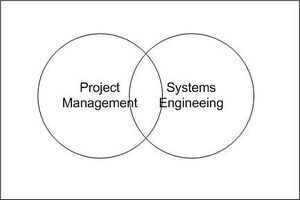Relationships between Systems Engineering and Project Management
This topic discusses the relationship between systems engineering (SE) and project management(PM). As with software engineering, there is a great deal of overlap. Depending on the environment and organization, the two disciplines can be disjoint, partially intersecting, or one can be seen as a subset of the other. While there is no standard relationship, the project manager and the systems engineer encompass the technical and managerial leadership of a project between them, and that requires the enterprise of each project manager and system engineer to work out the particular details for their context.
Overlap
There is a great deal of significant overlap between the scope of systems engineering as described here (in the SEBoK), CMMI (2011), and other resources; and the scope of project management as described in the PMBOK® Guide (PMI 2008) , CMMI (2011), and other resources as illustrated in Figure 1.
These sources describe the importance of understanding the scope of the work at hand, how to plan for critical activities, how to manage efforts while reducing risk, and how to successfully deliver value to a customer. The systems engineer working on a project will plan, monitor, confront risk, and deliver the technical aspects of the project. The project manager is concerned with the same kinds of activities for the overall project. Because of these shared concerns, there is room for confusion and tension between the roles of the project manager and the systems engineer on a given project. As shown in Figure 2, on some projects, there is no overlap in responsibility. On other projects, there may be shared responsibilities for planning and managing activities. In some cases, particularly for smaller projects, the project manager may also be the lead technical member of the team performing both roles of project manager and systems engineer.
Defining Roles and Responsibilities
Regardless of how the roles are divided up on a given project, the best way to reduce confusion is to explicitly describe the roles and responsibilities of the project manager and the systems engineer, as well as other key team members. The Project Management Plan (PMP) and the Systems Engineering Management Plan (SEMP) are key documents used to define the processes and methodologies the project will employ to build and deliver a product or service.
The PMP is the master planning document for the project. It describes all activities, including technical activities, to be integrated and controlled during the life of the program. The SEMP is the master planning document for the systems engineering technical elements. It defines SE processes and methodologies used on the project and the relationship of SE activities to other project activities. The SEMP must be consistent with, and evolve in concert with, the PMP. In addition, some customers have technical management plans and expectations that the project’s SEMP integrate with customer plans and activities. In the U.S. Department of Defense, most government project teams have a systems engineering plan (sep) with an expectation that the contractor’s SEMP will integrate and remain consistent with customer technical activities. In cases where the project is developing a component of a larger system, the component project’s SEMP will need to integrate with the overall project’s SEMP.
Given the importance of planning and managing the technical aspects of the project; an effective systems engineer will need to have a strong foundation in management skills, have experience, and possess strong technical depth. From developing and defending basis of estimates, planning and monitoring technical activities, identifying and mitigating technical risk, and identifying and including relevant stakeholders during the life of the project, the systems engineer becomes a key member of the project’s management and leadership team. Additional information on Systems Engineering Management and Stakeholder Needs and Requirements can be found in Part 3: Systems Engineering and Management.
References
Works Cited
CMMI. 2011. CMMI® for Development: Guidelines for Process Integration and Product Improvement. Old Tappan, New Jersey; Pearson Education.
PMI. 2008. A Guide to the Project Management Body of Knowledge (PMBOK® GUIDE)-Fourth Edition. Newtown Square, Pennsylvania; Project Management Institute, Inc.
Primary References
CMMI. 2011. CMMI for Development: Guidelines for Process Integration and Product Improvement. Old Tappan, NJ, USA: Pearson Education.
PMI. 2008. A Guide to the Project Management Body of Knowledge, 4th ed. Newtown Square, PA, USA: Project Management Institute (PMI).
Additional References
NASA. 2007. Systems Engineering Handbook, Revision 1. Washington, DC, USA: National Aeronautics and Space Administration (NASA). NASA/SP-2007-6105.
SEBoK Discussion
Please provide your comments and feedback on the SEBoK below. You will need to log in to DISQUS using an existing account (e.g. Yahoo, Google, Facebook, Twitter, etc.) or create a DISQUS account. Simply type your comment in the text field below and DISQUS will guide you through the login or registration steps. Feedback will be archived and used for future updates to the SEBoK. If you provided a comment that is no longer listed, that comment has been adjudicated. You can view adjudication for comments submitted prior to SEBoK v. 1.0 at SEBoK Review and Adjudication. Later comments are addressed and changes are summarized in the Letter from the Editor and Acknowledgements and Release History.
If you would like to provide edits on this article, recommend new content, or make comments on the SEBoK as a whole, please see the SEBoK Sandbox.
blog comments powered by Disqus
